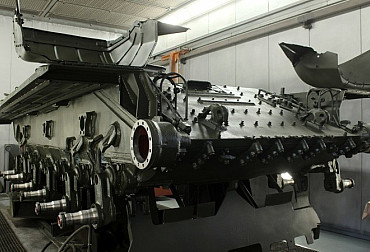Loitering ammunition on the scene again
In the context of the war in Ukraine, the phenomenon of loitering ammunition has reappeared, which are currently being widely used by the Russian side to strike Ukrainian critical infrastructure. Although in the Russian case these are so far strikes on static targets, the future use of loitering ammunition on mobile targets should be envisaged.
The so-called boom in the use of loitering ammunition occurred during the recent heated phase of the Nagorno-Karabakh dispute between Azerbaijan and Armenia, during which Azerbaijani forces were able to use Israeli-made loitering ammunition very effectively against Armenian static and mobile targets. Thanks to the technological sophistication and the ability to see the strikes of these means in virtually real time, an expert debate on the possible use of this type of weapon and its implications for the current conflict landscape began after the events of November 2020.
Loitering ammunition is also celebrating success in the ongoing conflict in Ukraine. As part of US assistance in recent months, the Ukrainian military has received hundreds of Switchblade 300 and Switchblade 600 kamikaze drones. In the case of the smaller Switchblade 300, it is a weapon that is designed to destroy lightly armoured targets or live enemy forces via a warhead equivalent to a 40mm grenade. The range of the Switchblade 300 is 10 kilometers and the drone is capable of staying airborne for 15 minutes. The Switchblade 600 then has a range of up to 40 kilometres and is capable of destroying tanks and other armoured vehicles thanks to a tandem Javelin anti-tank warhead. The Switchblade 600 can operate in the air for 40 minutes.
 Picture: Switchblade 300 | AeroVironment
Picture: Switchblade 300 | AeroVironment
Russia, in turn, deploys its indigenous KUB-BLA and Lancet weapon systems on a very limited basis as part of its use of stand-off munitions, but there is a lack of video footage to show their real benefits. Given the fact that Russia has recently begun cooperation with Iran in the area of loitering ammunition, it is likely that Russian commanders are not satisfied with the effectiveness of indigenous types of loitering ammunition. The aforementioned Iran is supplying Russia with systems known as the Shahid-136 (Russian for Geran-2). According to Iranian sources, the drone has a range of up to 1,800 km, but the Russian military is using these weapons in Ukraine at much shorter ranges in the lower hundreds of kilometres. Even so, this weapon system is causing significant damage and losses in Ukraine.
 Picture: Iranian kamikaze drones (loitering ammunition) Shahid-136 | Wikimedia Commons / CC BY-SA 4.0
Picture: Iranian kamikaze drones (loitering ammunition) Shahid-136 | Wikimedia Commons / CC BY-SA 4.0
The main advantage of loitering ammunition in general terms is the cost/performance ratio, where very good results in combat operations can be achieved at a relatively low cost. The implications for the Czech Army of deploying this weapon system can be twofold – offensive and defensive.
The offensive implication is a confirmation of the fact that loitering ammunition has its application on today's battlefield and can in many cases significantly contribute to success against both symmetric and asymmetric adversaries. Thus, it would be logical to consider the introduction of loitering ammunition within the Army, of all types – from small drones carried by individuals to the largest ones mounted on vehicles. In the context of the modernisation of Pandur vehicles in the Czech Armed Forces, where the most talked about is the replacement of the turret, given the experience from Nagorno-Karabakh and Ukraine, one could consider a turret that would carry a number of smaller loitering ammunition, similar to the US Stryker vehicle, in addition to the smaller calibre cannon, machine gun and anti-tank missiles. If we go further, we can consider, for example, the introduction of a special vehicle on a tracked or wheeled chassis, the main armament of which would be the standby ammunition placed in the container. Inspiration can be found in the US Marine Corps LAV-M vehicle.
Video: Stryker vehicle with integrated loitering ammunition / YouTube
In the case of loitering ammunition, the defensive implications cannot be overlooked. It is the way in which the Russian military has deployed loitering ammunition in Ukraine that is the aspect we should focus on, as Russia is the most likely future adversary of the Alliance. Countermeasures against loitering ammunition can be included in the building of a comprehensive multi-level air defence system. As with offensive implications, several solutions are offered to counter these dangerous means. One of these may be, for example, the installation of Skyranger-like modules on tracked or wheeled chassis, where again this option may be considered as part of the upgrade and purchase of new Pandur vehicles.
An interesting new development may be directed energy systems (microwaves and lasers), one of which, called Leonidas Stryker, was recently presented at AUSA. The Leonidas system on the Stryker chassis uses microwaves to destroy mainly smaller drones and this system has already been tested. Installing lasers on a wheeled or tracked chassis may also be an interesting option, similar to the DE M-SHORAD project using a 50 kW laser to destroy small drones and as a C-RAM asset if required. The DE M-SHORAD has also already undergone testing, and the manufacturer is scheduled to deliver the first four vehicles equipped with this laser system to the U.S. Army by the end of fiscal year 2022.





















